Hungarian State Opera

The Hungarian State Opera House (Magyar Állami Operaház) is a neo-Renaissance opera house located in central Budapest, on Andrássy út. Originally known as the Hungarian Royal Opera House, it was designed by Miklós Ybl, a major figure of 19th century Hungarian architecture. Construction began in 1875, funded by the city of Budapest and by Emperor Franz Joseph of Austria-Hungary, and the new house opened to the public in 1884. Before the closure of the "Népszínház" in Budapest, it was the second largest opera building in the city; today it is the largest opera house in Budapest and in Hungary.
Today, a secondary building, which has been part of the Hungarian State Opera company since 1951, is the Erkel Theatre (renamed as such in 1953), which originally opened in 1911 as the "Népopera" (The People's Opera). It was closed in 1915, modernised with seating capacity reduced to 2,400, and reopened in 1917 as the "Városi Színház" (City Theatre). It fulfilled many functions over the years, including being a cinema, until it came under the control of the State Opera House. Significantly renovated in 1961, it functioned as a second venue for the company until 2007 when once again, closure and renovations took place until its reopening in 2013.
Similar content
posted on
16 Feb 2015
26 Nov 2016
14 Nov 2016
posted on
20 Aug 2013
posted on
01 Mar 2012
posted on
12 Sep 2018




